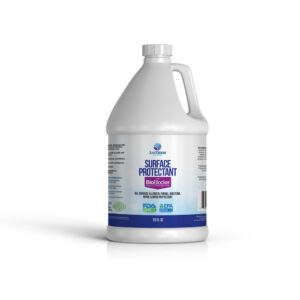What Is The Difference Between Chlorine Dioxide & Chlorine Bleach?
Unfortunately, the word “chlorine” is found in both Chlorine Dioxide (CLO2) and Chlorine Bleach (NaCLO). This has led to a lot of confusion.
Chlorine Dioxide:
- Does NOT release free chlorine
- Does NOT release harmful byproducts
- Highly effective on bacteria, virus, protozoa, algae, fungus
- Long term residual disinfection effectiveness
- Non-corrosive, does not react with ammonia
- Microbes do not build resistance
- Broad spectrum antimicrobial
- Kills spores
- Effective at a wide range of ph.
Chlorine dioxide is not another form of chlorine. We can draw an analogue to hydrogen and hydrogen cyanide, they are both gases, have the same first name, but completely different properties. So too with chlorine dioxide and chlorine, indeed one molecule does make a big difference.
Chlorine Dioxide is defined in the USA as having “no elemental free chlorine .. hence it does not chlorinate. It is because of this fact and the amazing chemistry of chlorine dioxide that it is slowly becoming an important tool in disinfection and oxidation in the world to-day.
Chlorine dioxide is a molecule consisting if 1 chlorine atom and 2 oxygen atoms. Abbreviated to CL02.
- It has a molecular weight of 67.45.
- It is a gas at normal temperatures and pressures.
- It has a melting point of -S9°C.
- It has a boiling point of 11 °C
- It is yellowish/ green and has an odor similar to that of chlorine.
- It is denser than air and is water soluble at standard temperatures and pressures up to 2500 ppm.
- It is explosive in air at concentrations > 10%
- It is prohibited from all form of transport, it is normally generated at the point of application.
- It will decompose in the presence of UV, high temperatures, and high alkalinity(> ph 12).
The physical and chemical properties of chlorine dioxide outline below will unravel its amazing capabilities.
- Chlorine dioxide does not dissociate in water. It stays as chlorine dioxide therefore its ability to operate as a disinfectant/sanitizer is independent of pH.
- Chlorine dioxide is an oxidant with a low redox potential. It has a redox potential of +o.96 mV compared to chlorine of +1.36 mV. There is no relationship between redox and disinfecting efficacy.
- Chlorine dioxide has a few specific chemical reactions. From this property a number of very interesting properties are derived:
- It has a very low toxicity rating, indeed some formulations have GRAS status.
- It is generally regarded as a ” no – irritant”. o It is not corrosive as a pure chlorine dioxide solution.
- Its reactions are selective hence as an oxidant reagent consumption is maximized in the redox reaction not through side reactions.
In conclusion, therefore we have a disinfectant / sanitizer which Is an oxidant with few chemical reactions, no pH limitations, very low toxicity, worldwide approval for drinking water, very high efficacy against micro-organisms, has a strong and measurable residual. The product when applied at use concentration in water will not corrode equipment; will not produce an environment harmful to workers or consumers.












